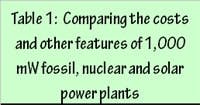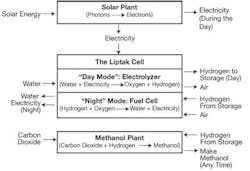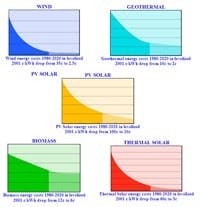In my September 2005 column(Can an Automation Engineer Control the Economy?), I described the control algorithms for the non-industrial process of the economy. I noted that the controlled variables (CV) and manipulated variables (MV) of all economies are the same. CVs include: GDP, deficit, dept, unemployment, value of the currency, the standing of the stock market, etc. The MVs include the interest rates and the policies concerning taxation, trade and energy policies, etc.
The capitalist and the communist “control loops” are quite different. The communist one is mostly feed forward (FF) and as such it keeps accumulating the model error until it self-destructs. On the other hand the capitalist control loop is a supply-demand modulated feedback (FB) control loop. Because the response of supply to demand is slow, this feedback configuration is slow to respond to changes in load variables (such as the cost of energy or the interest on loans) and requires retuning whenever the load or the process dynamics change. (For a general discussion of controlling non-industrial processes, refer to my 2005 articles in this magazine, which later became the basis of my lectures at Harvard University.)
The goal of this article is to describe the control system needed to smoothly convert the global economy from one that operated with exhaustible fuel resources (a batch process) to one that works with an inexhaustible and free energy supply (a continuous process). We know that for all transition loops it is essential to know the speed at which the set point can be changed if stability is to be maintained. We also know that the output of our control loop (the correction) must be proportional to the error (P), must reflect the integrated (I) area under the error curve (past inaction) and also project into the future by determining where the controlled process will get if the rate (D) of increasing error continues.
Lacking this understanding of the basics of process control (of any process) kept our “operators” (the political leaders of the planet) inactive and therefore the transition process has not even started. Today, the global economy in still controlled in a manual on-off mode where the incremental changes in the set points are made on a “lets see what happens” basis. What is worst, the operators don’t even understand the role of controller action and therefore some of their controllers operate in reverse. Examples of reverse action are the fighting of oil addiction by drilling for more oil or not realizing that with exhaustible supplies an increase in demand results in an increase in price while with inexhaustible supplies, the increase in demand causes prices to drop.
Measurements of the Controlled Process
Sir Nicholas Stern, former chief economist at the World Bank estimated that by 2020 the cost of continued reliance on fossil and nuclear fuels will reach 20% of the gross world product (GWP). The GWP today is approaching 50 trillion (the GDP of the United States was around $15 trillion in 2007 and is shrinking). If Sir Stern is correct, the cost of inaction (leaving the present economic control loop unchanged) will reach $10 trillion/yr by 2020, not to mention the social, environmental and “energy war” costs.
Therefore leaving the control loop of the economy in the “manual mode of inaction” would cost much more than gradually transferring to a clean and inexhaustible energy economy. Once the transition is completed, the fuel will be free and once the mass production of nanosolar collectors and reversible fuel cells (this invention of mine is described in my July 2008 column, Fuel Cell of the Future) start, the cost will drop even further.
The Properties of the Inexhaustible Energy Control Loop
Our planet receives more solar energy in 45 minutes than what mankind will need by the end of the century in a year. Therefore, if the global conversion to renewable fuels is completed by the end of this century, from that time fuel will be inexhaustible and free.
To meet the total global energy need expected for 2100 (when the life style of the 3rd world has reached our present one) all we need to do is to cover 3% to 4% of the Sahara (or the Mojave desert) with solar collectors.
Therefore, it is time to “retune the economy control loop”. The first step in this retuning process must be to get accurate sensors (start dealing with facts)! In order to accomplish this transformation, we must start building the world’s first solar-hydrogen demonstration power plant described in my book (Post-oil Energy Technology).
A key component of this solar-hydrogen demonstration power plant is the reversible fuel cell which I invented (see the Reversible Fuel Cell Model). During the day the RFC operates as an electrolyzer and generates hydrogen while at night it works as a fuel cell converting hydrogen back into electricity. Naturally, hydrogen would also be available as a transportation fuel, shipped and distributed as is LNG today. Considering that fuel cells are twice as efficient as internal combustion (IC) engines, hydrogen will not only be less expensive, but should provide twice the mileage as the IC engine and will emit no pollutant, only distilled water.
The World’s First Solar Hydrogen Power Plant
Figure 2 provides a “bird’s eye view” of my proposed solar hydrogen power plant.. If this plant is built close to an existing fossil power plant, it could also convert the carbon dioxide emission of that conventional power plant into methanol fuel. If an electric grid exists in the area, the excess solar electricity can be “stored” on that grid.
Figure 2: The components of the world’s first solar-hydrogen power plant.
As was shown in Table 1, all fossil and nuclear fuel deposits are exhaustible, in addition fossil is dirty, nuclear in unsafe. Similarly, biofuels generate carbon emissions and interfere with the food supply. Yet, contrast, the solar electricity and solar-hydrogen is already economical (Figure 3) and the transition can be done in a calm, orderly and economical fashion.
Figure 3: NREL projections of renewable energy cost 1980 to 2020.
I believe that the time for building has arrived, that it is time for mankind to install a new “control loop” for our economy, but what I believe is completely irrelevant! What is relevant is that the building and operating this, the world’s first solar-hydrogen demonstration power plant will close the debate on “what to do?” and will initiate action! The factual data generated will force “top management” (the voters in our free society) to tell our “operators” in the control room (the leaders of mankind) to stop running the system in manual on-off and reconfigure our control loop to optimize it for the smooth transition to the new inexhaustible energy economy.
Feedback control alone (market forces, cap and trade, increased fuel costs, taxation, etc.) will not be fast enough to convert our economy and in addition they will stifle the global economic growth. Instead, during the transition, temporary feed forward is required (applying large-scale public funding) to develop and demonstrate the feasibility of cost effective, clean, free and inexhaustible energy technologies.
To achieve these goals, to start this, the third industrial revolution will need vision and commitment, but so did the landing on the Moon. The scale of the effort will exceed that of the Marshall Plan. The transition will start not only with the building of solar-hydrogen power plants, but also with the installation of millions of solar roofs to make millions of homes “energy free” and with the conversion to a totally electric transportation system.
It is debatable, if our “operators” (political leaders) have any idea what process control is or how PID loops are tuned. I doubt that they understand the requirements for converting a batch process (operating with exhaustible resources) to a continuous one (operating with inexhaustible resources). It is also debatable how much fossil or nuclear resources are left on the planet, how much climate change can we live with or how long can we use our atmosphere as a global garbage dump. What is not debatable is that the conversion to a clean, free and inexhaustible energy economy is inevitable and understanding process control can help in the transition. The other thing that is not debatable is that we must not give reason to our grandchildren to ask: “Why did you not act?”

Leaders relevant to this article:








